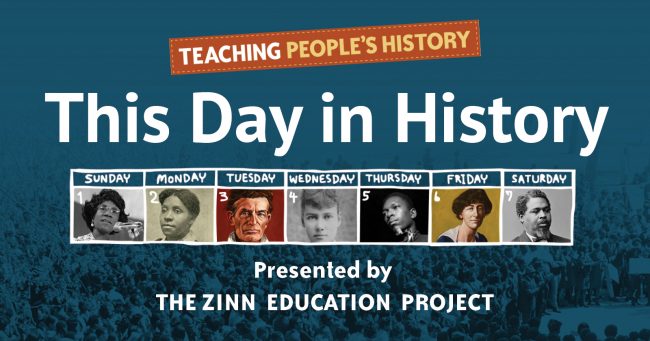We invite historians to contribute entries to the Zinn Education Project This Day in History series.
The popular series is hosted in full on our website and each day entries are shared widely on our Twitter, Facebook, and Instagram accounts. They are an excellent way to introduce teachers and others who follow the series to the book, film, podcast, or archive the story is drawn from. We add links to related lessons or other teaching resources for K-12.
For a new entry, we ask that historians select a date of note from the topic of their scholarship; one that can be used to tell a story. With rare exception, our #tdih are not the date of a famous person’s birth or death. We prefer an event of note. It can be helpful to scroll through the current entries to get an idea. They can be filtered by year, month, state, theme, and key word.
The length of the entries vary — most are about four to seven short paragraphs like the one on the Ponce Massacre. Some are ten paragraphs or more like the one on the Bath Riots.
Before drafting a post, we encourage historians to submit one or more proposed topics to the Zinn Education Project team (write to zep@zinnedproject.org). That way we can indicate which one (or more) is preferred. For example, we prioritize entries where we have a related classroom lesson or that fill a gap in our collection to date.
The entries should be written in a popular style, accessible to grades 7+. We request that a photo, primary document, or other image be included to illustrate the story. We prefer images that highlight the people’s history. For example, in a story about the attack on voting rights in Georgia, we do not include photos of Brian Kemp and instead feature the people fighting for voting rights. We avoid massacre photos, instead focusing on the people, the resistance. If there is a relevant book, we’d also want a hi-res image of the book cover.
We credit the author with a byline and short bio at the end. It is fine and in fact encouraged to excerpt from something the historian has already written. That way readers are directly introduced to the historian’s book and may order a copy.
We have a limited budget, so we cannot pay a fee for entries. However, we offer the historian and their work reach to a K-12 audience.
Once we receive the entry, we submit it for copyediting and light edits as needed to address our norms. For example, we capitalize Black when referencing people; use enslaved rather than slave; refer to people “freeing themselves” rather than “running away;” and avoid the passive voice. Before posting for the public, we share the link with the author for approval. Once approved and posted, we share it on the respective anniversary date each year and often on other dates when it relates to current events. The historian, publisher, and others can share the post whenever they like since it resides permanently on the site. It can also be periodically updated, as needed.







Twitter
Google plus
LinkedIn